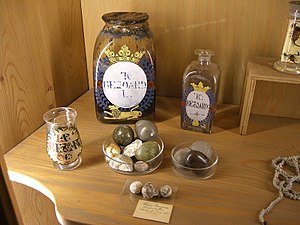
Bezoar

A bezoar is a mass found trapped in the gastrointestinal system, though it can occur in other locations. A pseudobezoar is an indigestible object introduced intentionally into the digestive system. A bezoar is a mass found trapped in the gastrointestinal system, though it can occur in other locations. A pseudobezoar is an indigestible object introduced intentionally into the digestive system. There are several varieties of bezoar, some of which have inorganic constituents and others organic. The term has both a modern (medical, scientific) and a traditional usage. Bezoars had value because they were believed to have the power of a universal antidote against any poison. Tradition held that a drinking glass which contained a bezoar would neutralize any poison poured into it. The word 'bezoar' comes from the Persian pād-zahr (پادزهر), which literally means 'antidote.' The Andalusian physician Ibn Zuhr (d. 1161), known in the West as Avenzoar, is thought to have made the earliest description of bezoar stones as medicinal items. Extensive reference to bezoars also appears in the Picatrix, which may have originated earlier. In 1575, French surgeon Ambroise Paré described an experiment to test the properties of the bezoar stone. At the time, the bezoar stone was deemed able to cure the effects of any poison, but Paré believed this was impossible. It happened that a cook at King's court was caught stealing fine silver cutlery and was sentenced to death by hanging. The cook agreed to be poisoned instead. Ambroise Paré then used the bezoar stone to no great avail, as the cook died in agony seven hours after taking poison. Paré had proved that the bezoar stone could not cure all poisons, contrary to popular belief at the time. Modern examinations of the properties of bezoars by Gustaf Arrhenius and Andrew A. Benson of the Scripps Institution of Oceanography have shown that they could, when immersed in an arsenic-laced solution, remove the poison. The toxic compounds in arsenic are arsenate and arsenite. Each is acted upon differently, but effectively, by bezoar stones. Arsenate is removed by being exchanged for phosphate in the mineral brushite, a crystalline structure found in the stones. Arsenite is found to bond to sulfur compounds in the protein of degraded hair, which is a key component in bezoars. A famous case in the common law of England (Chandelor v Lopus, 79 Eng Rep. 3, Cro. Jac. 4, Eng. Ct. Exch. 1603) announced the rule of caveat emptor ('let the buyer beware') if the goods they purchased are not in fact genuine and effective. The case concerned a purchaser who sued for the return of the purchase price of an allegedly fraudulent bezoar. (The law report does not discuss how the plaintiff discovered that the bezoar did not work.) Bezoars were important objects in cabinets of curiosity and natural history collections, especially for their use in early modern pharmacy and the study of animal health. The Merck Manual of Diagnosis and Therapy notes that consumption of unripened persimmons has been identified as causing epidemics of intestinal bezoars, and that up to 90% of bezoars that occur from eating too much of the fruit require surgery for removal.
